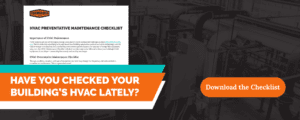In the past building ventilation was based on the maximum estimated number of occupants along with a number of other items. This is where we hear things like 2 air changes an hour. This was the best way to ensure safe indoor air quality until demand control ventilation came around.
As you can imagine, conference rooms that can hold hundreds of people require more air changes than a single room office. But what happens when the conference room isn’t in use?
With many existing systems the number of air changes is the same if the room is being used or not. This means systems bring in much more outside air than is needed and you end up paying to condition that air. If only there was a way to monitor changes in the indoor environment and adjust air changes based on the results. (In comes Demand Control Ventilation)
Demand Control Ventilation
As the name implies Demand Control Ventilation (DCV) looks at the demand for ventilation using sensors and supplies the outside air as needed. This type of system can work in small and large buildings alike.
Consider this example:
As employees arrive to a building in the morning for work, a DCV system will increase the number of air changes in occupied rooms. This is necessary because as the number of people increase in a space so does the amount of CO2. The DCV system will decrease demand for air changes when employees leave at the end of the day. This is due to the decrease in CO2 being produced in the building. With a DCV system your ventilation will adjust automatically during occupancy changes like this. The results are reduced energy costs, improved indoor air quality, and increased occupancy comfort.
Three Key Benefits to Demand Control Ventilation:
1. Reduce Energy Costs.
2. Improve Indoor Air Quality.
3. Increase Occupant Comfort.
How The Sensor Works


The sensor used to adjust the ventilation rates is most commonly a CO2 sensor that is hyper sensitive to CO2 levels in the air. As the number of people in a space increases, so do the CO2 levels. Seeing a spike in CO2 the system will increase the number of air changes until it hits the appropriate rate.
In 2004 ASHRAE updated the amount of outdoor air necessary for a given space. Today you need to be sure to bring in 7.5 CFM of outdoor air per person. In addition to that you need 0.06cfm of outdoor air per sq/ft of floor space. To calculate the airflow rate for your space simply take:
(number of occupants) x (7.5cfm) + (the # of sq/ft in the space) x (.06cfm)
CO2 monitors in the room use this equation to make real time adjustments to airflow.
Alternatively, some demand control ventilation systems will use an occupancy counting system to adjust rates. Turnstiles, ticket sales, security swipes or other methods to obtain the number of occupants can relay this information to the system. Based on the total occupancy of that event or meeting the DCV system adjusts appropriately.
Important Considerations
It is important to avoid these three common pitfalls when installing a DCV system.
1. Be sure to factor in exhaust when adjusting outdoor ventilation rates. Kitchens, restrooms, and copy rooms commonly have exhaust systems to factor in. You want to be careful not to reduce the outdoor air flow rate so low that it results in unwanted building pressurization. By accounting for the exhaust systems, you can avoid this issue.

2. You want to be cognizant of where you place the CO2 sensor. It is important that the system gets an accurate representation of the CO2 in the room. Placing the sensor by door, windows or in return air ducts can result in false CO2 readings. By staying away from these “hot spots” your system will accurately adjust the ventilation rates.
3. You need to maintain the sensors just like you maintain your HVAC system. CO2 sensors require calibration over time and should be adjusted during annual maintenances.
Have Questions?
Not sure if DCV makes financial sense for your facility? Want to chat with an expert? Call us at 1-800-237-3141, email sales@rasmech.com, chat with a support agent, or contact us online. We would be happy to help you out.
For a more in-depth look at DCV also check out “Applying Demand-Controlled Ventilation” by ASHRAE and “Code Notes” by the US Department of Energy.



